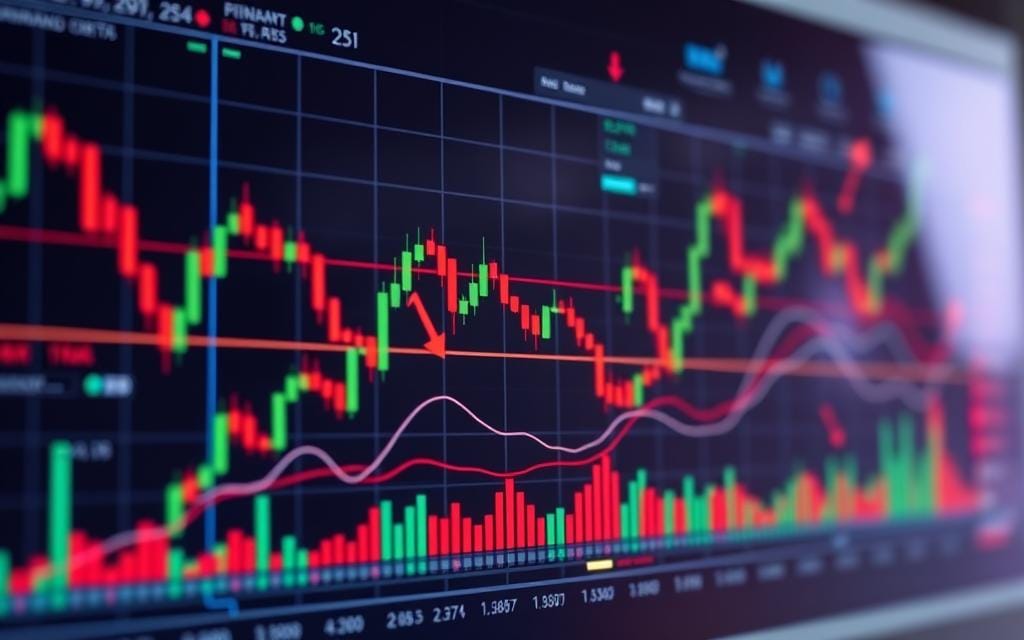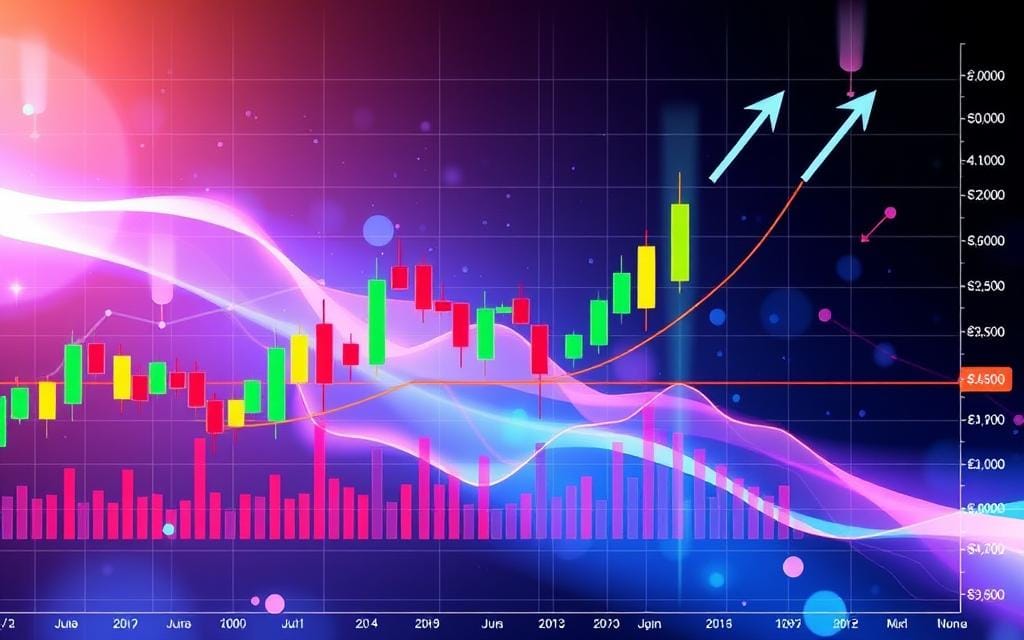Explore the technical analysis of the financial markets with proven strategies, tools, and insights to make informed investment decisions confidently.
Have you ever wondered what invisible forces steer the financial market trends and guide your trading decisions?
In the world of investments, technical analysis is key. It helps people understand market movements. By looking at charts and trading activity, it lets traders predict future prices well.
This method comes from trusted sources like Investopedia and John J. Murphy’s “Technical Analysis of the Financial Markets.” It gives a detailed view of price and volume. Sites like TradingView show how these ideas work in real life, offering tools for all traders.
Let’s dive into how technical analysis can change your trading. It uses statistical trends to find chances in the changing financial world.
Table of Contents
ToggleIntroduction to Technical Analysis
Technical analysis looks at past market data like price and volume to guess future trends. It believes that all news and events are already in stock prices. By studying past prices, traders look for signals to guide their choices.
The roots of technical analysis go back to the late 19th century. Charles Dow started the Dow Theory based on his market observations. It’s simple: stock prices show all the information, and analyzing them can uncover trends.
Today, many use technical analysis. They look at various indicators like moving averages and the relative strength index (RSI). These tools help them make smart choices.
For beginners, BabyPips offers easy-to-understand guides. By learning from past prices, they can guess future trends. This helps them improve their strategies and reduce risks.
The Balance provides detailed guides for personal investors. They focus on the importance of understanding indicators and their effect on prices. This knowledge helps investors make better choices.
Here’s a quick look at key resources for learning technical analysis:
| Source | Description |
|---|---|
| CMT Association | Insights into the history and credibility of technical analysis. |
| BabyPips | Beginner-friendly explanations of technical analysis principles. |
| The Balance | Introduction to technical analysis for personal investors. |
In short, technical analysis aims to predict future prices by studying past data. By mastering these principles, traders and investors can make informed decisions. They can better understand the financial markets.
Why Technical Analysis is Essential for Traders
Technical analysis is key for traders. It helps them understand market trends, manage risks, and plan their investments. Forbes says it’s crucial for making smart trading decisions.
Technical analysis helps traders find the best times to buy and sell. It uses past price data to predict future trends. This gives traders a chance to make better choices.

It also helps with risk management. Studies show it can help avoid big losses by spotting market downturns early. Traders can use this to set limits on their losses.
Successful traders like Jesse Livermore also value technical analysis. It teaches them to make consistent, rational decisions. This is vital for success in trading.
In conclusion, technical analysis is vital for traders. It helps them grasp market trends, predict price changes, and plan their investments. It’s a key tool for navigating the trading world.
Key Concepts of Technical Analysis
Understanding technical analysis is key for traders. It helps us grasp market psychology and use charting techniques well.
Price Action
Price action is the movement of a security’s price over time. It’s the base for most charting techniques. By looking at price patterns, traders can make smart decisions based on history.
Support and Resistance Levels
Support and resistance levels are important for traders. They show where a security might slow down or change direction. Support is where demand might increase, and resistance is where selling pressure might rise.
Trend Lines
Trend lines are straight lines on a chart that show support or resistance. They help understand a market’s direction. Trend lines connect highs or lows, showing market trends. They help traders spot trends and make better strategies.
Mastering these concepts improves our market understanding. Reading technical analysis books or articles helps a lot. Also, looking at historical data shows how these concepts work in real trading.
Popular Technical Indicators
Several popular technical indicators help in understanding trading signals and creating effective strategies. Each indicator offers unique insights into market movements. This helps traders make better decisions.

Moving Averages
Moving Averages are key in many trading plans. They smooth out price data to show the trend’s direction. By averaging prices over time, they reduce short-term changes and show the trend.
Traders often use simple and exponential Moving Averages. This helps them see market momentum.
Relative Strength Index (RSI)
The Relative Strength Index (RSI) measures price movement speed and change. It ranges from 0 to 100, showing when the market is overbought or oversold. RSI helps spot potential reversals and confirms trends.
Using RSI in analysis can reveal important trading signals.
Bollinger Bands
Bollinger Bands were created by John Bollinger. They are volatility bands above and below a moving average. The bands change size with market volatility.
Traders use Bollinger Bands to find overbought or oversold conditions and predict price breakouts. Adding Bollinger Bands to strategies can improve accuracy and manage risk.
Technical Analysis of the Financial Markets
Technical analysis is key to understanding financial markets like stocks, forex, and commodities. It involves studying price charts and historical data. This helps me see market trends and build strong forecasting models.
In the stock market, I look for trends and patterns to predict prices. This helps me make smart decisions about buying or selling. In forex, I analyze currency pairs and volumes to assess risks.
Market volatility is another important factor. High volatility means prices can change fast. So, I adjust my strategies to manage risks better.
Trading volumes are also crucial. High volumes show strong market interest and confirm price movements. This info is key for both short and long-term investments. By using volume data, I improve my forecasting and risk assessment.
Many sources prove technical analysis works well. Financial reports show its use in various markets. The Journal of Technical Analysis publishes research and case studies.
Notable economists and traders, like George Soros, also support its value. They share how technical analysis helps in understanding market behavior.
In summary, technical analysis is vital for financial market navigation. It uses historical data, market reports, and expert insights. This helps me refine my forecasting and make better investment choices.
How to Read Charts Like a Pro
Learning to analyze charts is key for any trader. Knowing how to read trading charts can improve your predictions and decisions. Let’s explore the types of charts and how to spot patterns.
Types of Charts: Line, Bar, and Candlestick
First, it’s important to know the different chart types. Line charts show an asset’s closing prices over time. They’re good for seeing the big picture but don’t have much detail.
Bar charts offer more info by showing an asset’s open, high, low, and close prices. They’re better for detailed analysis.
Candlestick charts are the most detailed. Each ‘candlestick’ shows price changes in a time frame. This helps traders spot patterns fast.

With these charts, traders can see the whole market trend. They use both simple bar and detailed candlestick charts to improve their skills.
Identifying Chart Patterns
Spotting patterns is vital in chart analysis. Patterns like the ‘head and shoulders’ signal trend changes. The ‘cup and handle’ often shows a pattern that continues.
Seeing these patterns in charts can predict market moves. Resources like StockCharts.com’s ChartSchool and “Encyclopedia of Chart Patterns” by Thomas Bulkowski are great for learning. They explain chart patterns and their importance.
Financial analysts’ white papers also use real examples. They show how these patterns work in practice. This adds a real-world view to the theory.
Common Mistakes to Avoid in Technical Analysis
Many traders fall into common pitfalls while mastering technical analysis. These mistakes can greatly affect their success. It’s crucial to avoid these pitfalls to build a strong trading strategy.
Over-Relying on Indicators
One big mistake is relying too much on indicators. While they offer valuable insights, relying only on them can lead to bad decisions. It’s important to use indicators alongside other analysis methods for a full understanding.
Ignoring Market Context
Another mistake is ignoring the market’s broader context. Financial experts stress the need to see indicators within the larger market picture. This includes understanding macroeconomic factors, news, and market sentiment. Without this context, traders might make unprofitable trades.
Failing to Manage Risk
Effective risk management is key in trading. Many traders focus too much on gains and forget about risk. Financial institutions publish strategies like setting stop-loss orders and diversifying. These help reduce losses and improve trading psychology.
| Common Mistake | Impact | Solution |
|---|---|---|
| Over-Relying on Indicators | Leads to poor decision-making | Combine with other analysis methods |
| Ignoring Market Context | Misinterprets signals | Understand macroeconomic factors |
| Failing to Manage Risk | Increased losses | Implement risk management strategies |
The Role of Volume in Technical Analysis
Volume is key in technical analysis. It confirms trends and shows when trends might change. It helps understand the strength of market movements and spot new trends.
Tools like the On-Balance Volume (OBV) offer deep insights. Joseph Granville showed that big volume changes often signal price moves. This makes OBV great for spotting when the market is gathering or losing momentum.
Looking at volume indicators helps more than just confirm trends. It also checks the market’s health. High volume means more liquidity, making big trades easier. Low volume might mean the market is at risk of manipulation, as prices can change easily with fewer trades.

Now, let’s dive into some key points:
- Bloomberg’s market analysis shows big volume before price changes. It’s crucial for predicting market shifts.
- Joseph Granville’s OBV work highlights volume’s role in confirming trends and spotting divergences that hint at reversals.
- Studies on market microstructure link volume analysis, price impact, and market liquidity trends.
Grasping volume’s role in technical analysis helps predict price moves and improve trading strategies. Using volume indicators well can be a game-changer for traders.
| Volume Indicator | Purpose | Key Insight |
|---|---|---|
| OBV (On-Balance Volume) | Trend Confirmation | Helps detect accumulation/distribution phases |
| Volume Rate of Change (VROC) | Momentum Analysis | Measures the rate of change in trading volume |
| Accumulation/Distribution Line (A/D Line) | Trend Strength | Combines price and volume to assess buying/selling pressure |
| Volume Weighted Average Price (VWAP) | Price Analysis | Gives average trading price weighted by volume |
Using these volume indicators gives a detailed look at market behavior. It helps traders refine their strategies and react to changes in liquidity. By focusing on trading volume, traders can better handle the financial markets’ complexities.
Combining Technical and Fundamental Analysis
Using both technical and fundamental analysis helps me create a strong investment plan. Each method gives different views that help predict market changes. This way, I can make better decisions and understand the market better.
Balancing Short-term and Long-term Perspectives
It’s important to balance short-term and long-term views in investing. Technical analysis gives quick insights into market trends. For example, candlestick patterns or moving averages show when to buy or sell.
On the other hand, fundamental analysis looks at long-term trends. It examines financial history, company performance, and economic indicators. By mixing both, I can grab quick wins and plan for the future.
Integrating News Events
Adding news to my analysis makes my strategy more flexible. News can cause markets to change quickly. For instance, earnings reports or global events can shift market feelings fast.
Also, knowing how news affects the market through economic indicators is key. Things like interest rates, GDP, or job numbers help me understand the big picture. This makes my predictions stronger.
By combining technical patterns, fundamental data, and current news, I develop a solid trading strategy. It’s ready to adjust to both quick changes and long-term trends.
Building a Personal Trading Strategy Using Technical Analysis
Creating a winning trading plan is all about matching it to my risk level and goals. I start by picking the right technical indicators for my strategy.
Tools like Moving Averages and the Relative Strength Index (RSI) help spot market trends. Learning from traders like Ray Dalio teaches me the importance of different analytical methods.
Backtesting is key to making my trading system work. It means testing my strategy on past market data to see how it might do.
The American Association of Individual Investors has great resources for learning how to backtest. With practice, I can make my strategy better and feel more confident in it.
Adding market psychology to my analysis makes my strategy even stronger. It’s important to know how emotions affect the market.
Courses on Coursera help me understand how market mood can change technical patterns. By mixing these parts, I build a trading system that can handle different market situations well.
Ready to master market trends? Visit bizeconanalysis.com for expert guidance on Technical Analysis of the Financial Markets and elevate your trading skills today!
FAQ
What is technical analysis in the financial markets?
Technical analysis is a way to look at investments and find good times to buy or sell. It uses past market data like price and volume to guess future trends. Important sources include Investopedia and John J. Murphy’s book “Technical Analysis of the Financial Markets.”
Why is technical analysis important for traders?
It’s key for traders to manage risk and find the right times to buy or sell. Tools like momentum indicators help make smart choices. Forbes and The Journal of Finance have articles that show its value.
What are the basic concepts of technical analysis?
Key ideas include price action, support and resistance levels, and trend lines. Price action shows how a security’s price moves. Support and resistance levels help spot where the market might change direction. Trend lines show the market’s trend. You can learn more in technical analysis books and articles.
What are popular technical indicators used in market analysis?
Popular indicators are Moving Averages, Relative Strength Index (RSI), and Bollinger Bands. Moving Averages smooth out price data to show trends. RSI measures price movement speed and change. Bollinger Bands show market volatility. Investopedia explains these, and trading platform tutorials show how to use them.
How does volume impact technical analysis?
Volume is crucial in technical analysis. It shows if a trend is strong or if it might change. Volume indicators help see if the market is liquid and open to manipulation. Bloomberg and Joseph Granville’s work on the On-Balance Volume (OBV) indicator highlight its importance.
Can technical analysis be combined with fundamental analysis?
Yes, mixing technical and fundamental analysis is a good way to make decisions. It looks at short-term price trends and long-term economic factors. The Financial Times and Warren Buffett’s strategies show how both can work together.
What are common mistakes to avoid in technical analysis?
Avoid over-relying on indicators and ignoring the big picture. Also, don’t forget to manage risk. Experienced traders warn against these mistakes. Financial analysts and institutions stress the need to consider the market context and manage risk.
How can I build my personal trading strategy using technical analysis?
Start by thinking about your risk tolerance and investment goals. Create a trading plan that includes backtesting and using technical indicators. Learning from Ray Dalio and resources from the American Association of Individual Investors can help.















